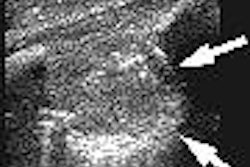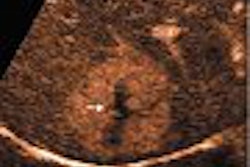(Radiology Review) Benign prostatic hyperplasia originating in the outer gland may mimic prostate cancer, according to researchers in China. Both pathologies appear on endorectal ultrasound as hypoechoic, so transrectal ultrasound-guided biopsy should be used to provide histological differentiation, according to Dr. Jie Tang and colleagues. Their study appeared in the April edition of the Journal of Ultrasound in Medicine.
Previous research and traditional thinking has dictated that benign hyperplastic areas only appeared in the central prostate gland, the authors stated. During a 42-month period, they performed prostate biopsies in 472 patients suspected of having prostate cancer. Prior to endorectal sonography, patients were given a cleansing enema and antibiotic prophylaxis. Sonography was performed using a 6- to 10-MHz endorectal transducer with the patient in the left lateral decubitus position.
The team at the Chinese People's Liberation Army General Hospital in Beijing determined that while the majority of the 240 patients with hypoechoic nodules had prostate cancer, 22 patients (9.17%) had biopsy-proven focal benign hyperplasia within the outer gland.
Patients without hypoechoic nodules had sextant biopsies performed, while patients with nodules had two biopsies per site followed by sextant biopsies. Tissue samples were taken using an automated core biopsy device, a Biopty gun (C.R. Bard, Covington, GA), with an 18-gauge needle. "Focal nodules were seen as well-circumscribed with an ovoid shape and smooth surface in 18 patients," they stated. Among all the patients, 310 (65.7%) had a benign histologic finding, and 162 (34.32%) had a histologic diagnosis of prostate cancer. The majority of benign hypoechoic nodules on ultrasound were smooth, well-circumscribed oval lesions with an average diameter of 1.4 cm.
Anatomically, Dr. Jie Tang and colleagues described the prostatic outer gland as a combination of the central zone and peripheral zone, as the two zones are not easily distinguished sonographically, even using high-resolution endorectal transducers.
"Benign hyperplasia may sometimes originate in the prostatic outer gland, and may appear as a hypoechoic nodule, similar to the appearance of prostate cancer," the authors concluded. They recommended further analysis of the histologic differences comparing hyperplasia in the inner gland with hyperplasia in the outer gland.
"Correlation between Hypoechoic Nodules on Ultrasonography and Benign Hyperplasia in the Prostatic Outer Gland"
Tang, Jie, et al
Department of Ultrasound, Chinese People's Liberation Army General Hospital, 28 Fuxing Road, Beijing 100853, China
J Ultrasound Med 2005 (April) 24:483-488
By Radiology Review
April 15, 2005
Copyright © 2005 AuntMinnie.com



















